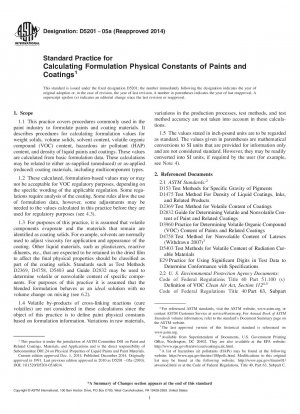ASTM D5201-05a(2014)
Standard Practice for Calculating Formulation Physical Constants of Paints and Coatings
- Standard No.
- ASTM D5201-05a(2014)
- Release Date
- 2005
- Published By
- American Society for Testing and Materials (ASTM)
- Status
- Replace By
- ASTM D5201-05a(2020)
- Latest
- ASTM D5201-05a(2020)
- Scope
4.1 Physical constants of paints and coatings are required in all aspects of their formulation, manufacture and use. This practice demonstrates standard methods agreed upon for calculating formulation values for some of these physical constants. The calculations are the same for either metric or inch/pound units.
4.2 These formula values may not be used to replace measured values required by government regulations unless specifically stated in the governing documents.
4.3 Some regulations allow compliance determination using formulation data instead of analytical data. This formulation data may not yield the same results as the required analytical method, which could be performed on a sample from any production batch of the coating. In these cases, the user may wish to compare formulation data to analytical data and develop a factor that adjusts for variability of raw materials, variability of production batches, cure volatiles, and variability of the analytical methods.
1.1 This practice covers procedures commonly used in the paint industry to formulate paints and coating materials. It describes procedures for calculating formulation values for weight solids, volume solids, solvent content, volatile organic compound (VOC) content, hazardous air pollutant (HAP) content, and density of liquid paints and coatings. These values are calculated from basic formulation data. These calculations may be related to either as-supplied (unreduced) or as-applied (reduced) coating materials, including multicomponent types.
1.2 These calculated, formulation-based values may or may not be acceptable for VOC regulatory purposes, depending on the specific wording of the applicable regulation. Some regulations require analysis of the coating. Some rules allow the use of formulation data, however, some adjustments may be needed to the values calculated in this practice before they are used for regulatory purposes (see 4.3).
1.3 For purposes of this practice, it is assumed that volatile components evaporate and the materials that remain are identified as coating solids. For example, solvents are normally used to adjust viscosity for application and appearance of the coating. Other liquid materials, such as plasticizers, reactive diluents, etc., that are expected to be retained in the dried film to affect the final physical properties should be classified as part of the coating solids. Standards such as Test Methods D2369, D4758, D5403 and Guide D2832 may be used to determine volatile or nonvolatile content of specific components. For purposes of this practice it is assumed that the blended formulation behaves as an ideal solution with no volume change on mixing (see 6.2).
1.4 Volatile by-products of cross-linking reactions (cure volatiles) are not considered in these calculations since the object of this practice is to define paint physical constants based on formulation information. Variations in raw materials, variations in the production pr......
ASTM D5201-05a(2014) Referenced Document
- ASTM D1475 Standard Test Method For Density of Liquid Coatings, Inks, and Related Products
- ASTM D153 Standard Test Methods for Specific Gravity of Pigments
- ASTM D2369 Standard Test Method for Volatile Content of Coatings
- ASTM D2832 Standard Guide for Determining Volatile and Nonvolatile Content of Paint and Related Coatings
- ASTM D3960 Standard Practice for Determining Volatile Organic Compound (VOC) Content of Paints and Related Coatings
- ASTM D4758 Standard Test Method for Nonvolatile Content of Latexes
- ASTM D5403 Standard Test Methods for Volatile Content of Radiation Curable Materials
- ASTM E29 Standard Practice for Using Significant Digits in Test Data to Determine Conformance with Specifications
ASTM D5201-05a(2014) history
- 2020 ASTM D5201-05a(2020) Standard Practice for Calculating Formulation Physical Constants of Paints and Coatings
- 2005 ASTM D5201-05a(2014) Standard Practice for Calculating Formulation Physical Constants of Paints and Coatings
- 2005 ASTM D5201-05a(2010) Standard Practice for Calculating Formulation Physical Constants of Paints and Coatings
- 2005 ASTM D5201-05a Standard Practice for Calculating Formulation Physical Constants of Paints and Coatings
- 2005 ASTM D5201-05 Standard Practice for Calculating Formulation Physical Constants of Paints and Coatings
- 2003 ASTM D5201-03a Standard Practice for Calculating Formulation Physical Constants of Paints and Coatings
- 2003 ASTM D5201-03 Standard Practice for Calculating Formulation Physical Constants of Paints and Coatings
- 2001 ASTM D5201-01 Standard Practice for Calculating Formulation Physical Constants of Paints and Coatings
- 1997 ASTM D5201-97 Standard Practice for Calculating Formulation Physical Constants of Paints and Coatings

Copyright ©2024 All Rights Reserved